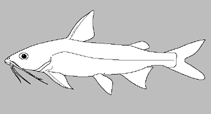Add your observation in Fish WatcherAquaMaps webservice down at the moment
Upload your photos and videos
Google imageNo image available for this species;
drawing shows typical species in Ariidae.
Google imageNo image available for this species;
drawing shows typical species in Ariidae.
Classification / Names Common names | Synonyms | Catalog of Fishes(genus, species) | ITIS | CoL | WoRMS | Cloffa
Teleostei (teleosts) > Siluriformes (Catfishes) > Ariidae (Sea catfishes) > Ariinae
Etymology: Cathorops: Greek, kathorao = to observe, to watch + Greek, ops = appearance (Ref. 45335).
More on author: Meek.
Etymology: Cathorops: Greek, kathorao = to observe, to watch + Greek, ops = appearance (Ref. 45335).
More on author: Meek.
Environment: milieu / climate zone / depth range / distribution range Ecology
Freshwater; brackish; demersal. Tropical
Distribution Countries | FAO areas | Ecosystems | Occurrences | Point map | Introductions | Faunafri
Central America: Atlantic draining rivers from Panuco River basin in Mexico to Izabal Lake in Guatemala (Ref. 58032). Materials examined from río Usumacinta and
lago Izabal basins, formerly treated as Cathorops aguadulce (e.g. Castro-Aguirre et al., 1999; Miller et al., 2005; Betancur-R. and Willink, 2007), are treated as Cathorops kailolae(Ref. 75004). Examination of more materials is needed to determine whether the population reported from other localities reported by Miller et al., 2005 from other localities (i.e. río Panuco, río Tecolutla, río Coatzacoalcos, and Gulf of Mexico) should be separated (Ref. 75004).
Size / Weight / Age
Short description Identification keys | Morphology | Morphometrics
Dorsal spines (total): 1; Dorsal soft rays (total): 7; Anal soft rays: 21. Differs from all other species of Cathorops by having the following features: fleshy papillae intercalated with gill rakers on first two gill arches; posterior margin of pectoral-fin spine with long and conspicuous serrations (except in Cathorops kailolae, Cathorops melanopus, Cathorops multiradiatus, and Cathorops tuyra); gill rakers on first arch 14-16; and snout length 9.3-11.6% SL. Can be further separated from Cathorops belizensis by its longer supraoccipital process 11.5-16.3% SL (vs. 8.8-10.5% SL), larger orbital diameter 4.6-6.9 % SL (vs. 3.6-4.4% SL), and shorter interorbital distance 9.9-12.3 (vs. 12.9-15.1% SL); from Cathorops higuchii by its gill rakers on second arch 13-16 (vs. 17-21), and larger orbital diameter 4.6-6.9 (vs. 3.3-4.4% SL); from Cathorops kailolae by its longer distance from tip of snout to dorsal-fin origin 39.0-40.7 (vs. 33.1- 38.0% SL); from Cathorops mapale species group by its gill rakers on second arch 13-16 (vs. 17-21); from Cathorops melanopus by its longer distance from tip of snout to dorsal-fin origin 39.0-40.7 (vs. 30.0-32.6% SL), and longer distance from tip of snout to posterior margin of dorsomedian groove of neurocranium 22.9-26.4 (vs. 17.9-19.1% SL) (Ref. 75004).
Found in large to medium-sized rivers, lagoons and small drainages. Typically inhabits freshwaters, but may also occur in marine waters (Ref. 75004).
Life cycle and mating behavior Maturity | Reproduction | Spawning | Eggs | Fecundity | Larvae
Main reference
Upload your references | References | Coordinator : Ferraris, Jr., Carl J. | Collaborators
Marceniuk, A.P. and R. Betancur-R, 2008. Revision of the species of the genus Cathorops (Siluriformes: Ariidae) from Mesoamerica and the Central American Caribbean, with description of three new species. Neotrop. Ichthyol. 6(1):25-44. (Ref. 75004)
CITES
Not Evaluated
Threat to humans
Traumatogenic (Ref. 58010)
Human uses
Fisheries: commercial
FAO - Publication: search | FishSource |
More information
Trophic ecology
Food items
Diet composition
Food consumption
Food rations
Predators
Food items
Diet composition
Food consumption
Food rations
Predators
Ecology
Ecology
Ecology
Population dynamics
Growth parameters
Max. ages / sizes
Length-weight rel.
Length-length rel.
Length-frequencies
Mass conversion
Recruitment
Abundance
Growth parameters
Max. ages / sizes
Length-weight rel.
Length-length rel.
Length-frequencies
Mass conversion
Recruitment
Abundance
Life cycle
Reproduction
Maturity
Maturity/Gills rel.
Fecundity
Spawning
Spawning aggregations
Eggs
Egg development
Larvae
Larval dynamics
Reproduction
Maturity
Maturity/Gills rel.
Fecundity
Spawning
Spawning aggregations
Eggs
Egg development
Larvae
Larval dynamics
Anatomy
Gill area
Brain
Otolith
Gill area
Brain
Otolith
Physiology
Body composition
Nutrients
Oxygen consumption
Swimming type
Swimming speed
Visual pigments
Fish sound
Diseases & Parasites
Toxicity (LC50s)
Body composition
Nutrients
Oxygen consumption
Swimming type
Swimming speed
Visual pigments
Fish sound
Diseases & Parasites
Toxicity (LC50s)
Genetics
Genetics
Heterozygosity
Heritability
Genetics
Heterozygosity
Heritability
Human related
Aquaculture systems
Aquaculture profiles
Strains
Ciguatera cases
Stamps, coins, misc.
Aquaculture systems
Aquaculture profiles
Strains
Ciguatera cases
Stamps, coins, misc.
Tools
E-book | Field guide | Length-frequency wizard | Life-history tool | Point map | Classification Tree
| Catch-MSY |
Special reports
Download XML
Internet sources
AFORO (otoliths) | Aquatic Commons | BHL | Cloffa | BOLDSystems | Websites from users | Check FishWatcher | CISTI | Catalog of Fishes: genus, species | DiscoverLife | ECOTOX | FAO - Publication: search | Faunafri | Fishipedia | Fishtrace | GenBank: genome, nucleotide | GloBI | Google Books | Google Scholar | Google | IGFA World Record | MitoFish | Otolith Atlas of Taiwan Fishes | PubMed | Reef Life Survey | Socotra Atlas | Tree of Life | Wikipedia: Go, Search | World Records Freshwater Fishing | Zoological Record
Estimates based on models
Phylogenetic diversity index (Ref. 82804): PD50 = 0.5000 [Uniqueness, from 0.5 = low to 2.0 = high].
Bayesian length-weight: a=0.00490 (0.00250 - 0.00959), b=3.13 (2.96 - 3.30), in cm total length, based on LWR estimates for this (Sub)family-body shape (Ref. 93245).
Trophic level (Ref. 69278): 4.3 ±0.8 se; based on size and trophs of closest relatives
Resilience (Ref. 120179): High, minimum population doubling time less than 15 months (Preliminary K or Fecundity.).
Fishing Vulnerability (Ref. 59153): Low vulnerability (18 of 100).




